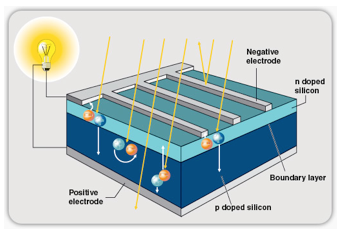Solar PV Basics
So …. you’d like to install a solar power system, or maybe even help other people to understand solar, purchase it, and go on to use it in their homes ?
Well, you’d better learn a little something about it.
Myths
1. The first myth we need to dispel is the hot water myth. We are not talking about anything to do with water – so there is no tank and especially no water tank on the roof. A solar electric generation system (or Solar PV system) makes electricity using panels on our roof together with another device on the ground level called an inverter. Solar Hot Water is another great technology, but we are discussing generation of electricity here.
2. The second myth is the ‘lights go off when the sun sets’. In a grid connected PV system, the electricity network is still there if you need it, so there is no need to worry if the day is cloudy, or if you need to use an energy intensive appliance, such as a welder.
Basic solar electricity principles
Solar panels use a clever and amazing technology that converts the energy in light (known as ‘photons’) directly into electricity. Light hits the surface of the panels, which contain solar cells, and a percentage of the energy is absorbed by the semiconductor material in the cells, and passed out through the junction box as Direct Current (DC) electricity. This is the same type of electricity that comes out of batteries (but not the same type of electricity that comes from your powerpoint, which is Alternating Current (AC). The energy that is not absorbed becomes heat, the same as it would have for the tiles or tin sheet that lay under the panels.
The absorption process described above is called the photovoltaic effect, giving us the abbreviation PV. It is made possible because of the properties of the material, in most cases silicon wafers that have been processed to have two layers with different characteristics. You can read more about this elsewhere but a diagram of the basic layers in the cell is shown below, complete with yellow lines to symbolise the sun’s rays.

So …. now you know a little bit about the basic principle. Now, what makes up a solar PV system ?
As we mentioned before, a solar generation system isn’t just panels. These are the main parts of the system:
- panels (to convert light energy to electrical energy);
- racks (to hold the panels on the roof so they don’t blow away, and to keep panels cool);
- an inverter (to ‘manage’ the panels, to convert the DC electricity into AC electricity, and to provide some safety functions);
- cables (to transport the electricity from the panels to the inverter, and from the inverter to the main electrical switchboard or meterbox); and
- the solar meter (to record the energy production, gross or net).
Panels
Solar panels are rated for their power under certain conditions. The conditions are 25 degrees C, with light intensity of 1000W/square metre and AM1.5. These are called standard test conditions (STC) or less often, peak conditions. These conditions are set so that comparison between panels is possible in a broad sense, and thus the power rating lets us calculate the relative performance of panels in one sense.
Power (P) is given in watts (W), and power is calculated by multiplying current (I) [given in Amps A] and voltage (V) [given in volts V]. Current is roughly proportional to the amount of light falling on the panel (more light, more photons -> more electrons flowing), whilst the voltage of the panel is a function of the material the solar cells are made up of, the internal resistance, and the temperature.
Interestingly, as the panels get hotter the voltage goes down. The problem is most pronounced in mono crystalline cells, a little less so in multicrystalline cells, and significantly less of a problem in thin film solar panels (but those need more area). So, in contrast to solar hot water collector panels, we actually want to keep our photovoltaic panels cool (this is the reason most backing sheets are white, and why we like to rack them 10cm or so above the roof, to allow for airflow. BP Solar have developed a special backing sheet that helps to keep the panel cool.
Three main types of panels, and the classification is derived from the method of manufacture. From left, multi/poly crystalline, monocrystalline, and amorphous aSi.
People claim various things about the different technologies, but essentially you’ll see very similar performance from mono and poly panels of the same power rating.
In terms of energy payback, the worst is mono, followed by poly with the best being aSi.
In terms of cost, aSi is cheapest to make, then poly, with mono the most expensive.
All cells have a performance drop over time, and this is pretty linear for mono and poly (down to 80% of install levels after 25 years). aSi is however, less stable and tends to lose a lot of performance in the first year, than a fair chunk in the 2nd, before stabilising at the rating values.



